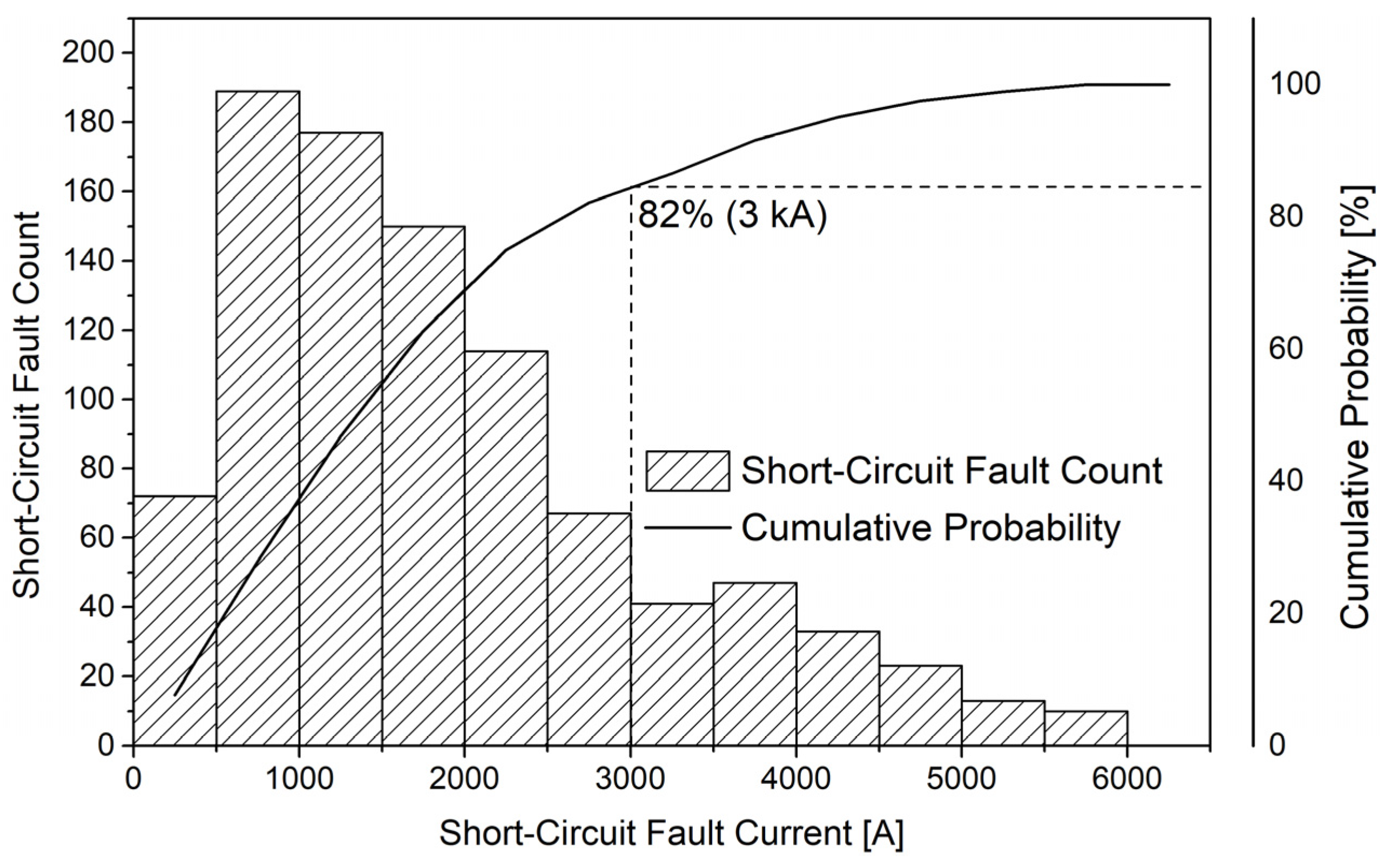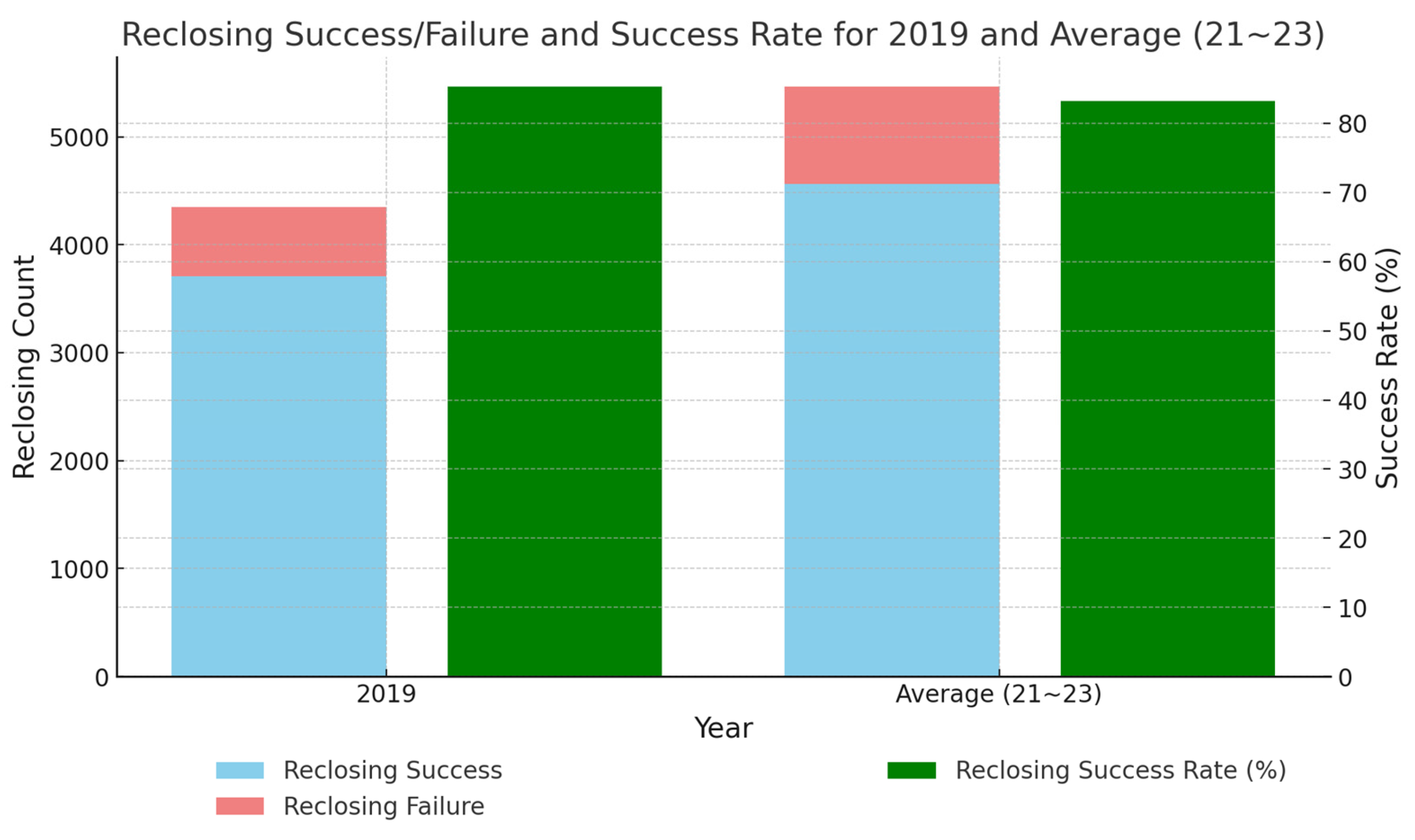Refinement of Recloser Operation and Safety Enhancement in Distribution Systems: A Study Based on Real Data
Abstract
:1. Research Background and Necessity
2. Analysis of Recloser Operational Elements
2.1. Reclosing Count
2.2. Recloser Sequence
2.3. High-Current Interruption in Reclosers
3. Proposed Recloser Operation Methods
3.1. Reclosing Count
3.2. Recloser Sequence
3.3. High-Current Interruption in Reclosers
4. Validation of the Proposed Method
5. Conclusions
Author Contributions
Funding
Data Availability Statement
Conflicts of Interest
References
- Azari, R.N.; Chitsazan, M.A.; Niazazari, I. Optimal Recloser Setting, Considering Reliability and Power Quality in Distribution Networks. Am. J. Electr. Power Energy Syst. 2017, 6, 1–6. [Google Scholar] [CrossRef]
- Hussain, B.; Sharkh, S.M.; Hussain, S. An Adaptive Relaying Scheme for Fuse Saving in Distribution Networks with Distributed Generation. IEEE Trans. Power Deliv. 2013, 28, 669–677. [Google Scholar] [CrossRef]
- Jamali, S.; Borhani-Bahabadi, H. Recloser Time–Current–Voltage Characteristic for Fuse Saving in Distribution Networks with DG. IET Gener. Transm. Distrib. 2017, 11, 272–279. [Google Scholar] [CrossRef]
- Naiem, A.F.; Hegazy, Y.; Abdelaziz, A.Y. A Classification Technique for Recloser–Fuse Coordination in Distribution Systems with Distributed Generation. IEEE Trans. Power Deliv. 2012, 27, 176–185. [Google Scholar] [CrossRef]
- Short, T.A. Identification of Fuse and Recloser Operations in a Radial Distribution System. IEEE Trans. Power Deliv. 2007, 22, 2370–2377. [Google Scholar]
- Celli, G.; Ghiani, E.; Pilo, F.; Tedde, S. A Probabilistic Fault Arc Reignition Model for MV Distribution Networks. In Proceedings of the 17th Power Systems Computation Conference, Stockholm, Sweden, 22–26 August 2011. [Google Scholar]
- Srivastava, S.; Tripathi, J.M.; Mohanty, S.R. Optimal Overcurrent Relay Coordination with Distributed Generation Using Hybrid Particle Swarm Optimization-Gravitational Search Algorithm. Electr. Power Compon. Syst. 2016, 44, 506–517. [Google Scholar] [CrossRef]
- Chang, G.W.; Chu, S.Y.; Wang, H.L. An Improved Backward/Forward Sweep Load Flow Algorithm for Radial Distribution Systems. IEEE Trans. Power Syst. 2007, 22, 882–884. [Google Scholar] [CrossRef]
- Martinez, J.A.; Martin-Arnedo, J. Voltage Sag Studies in Distribution Network—Part II: Voltage Sag Assessment. IEEE Trans. Power Deliv. 2006, 21, 1679–1688. [Google Scholar] [CrossRef]
- Zeineldin, H.H.; El-Saadany, E.F. Fault Current Limiters to Mitigate Recloser-Use Miscoordination with Distributed Generation. In Proceedings of the 10th IET International Conference on Developments in Power System Protection (DPSP 2010), Manchester, UK, 29 March–1 April 2010; pp. 1–7. [Google Scholar]
- Khan, W.A.; Bi, T.; Jia, K. A review of single phase adaptive auto-reclosing schemes for EHV transmission lines. Prot. Control Mod. Power Syst. 2019, 4, 1–10. [Google Scholar] [CrossRef]
- Mehdi, A.; Kim, C.H.; Hussain, A.; Kim, J.S.; Hassan, S.J.U. A Comprehensive Review of Auto-Reclosing Schemes in AC, DC, and Hybrid (AC/DC) Transmission Lines. IEEE Access 2021, 9, 74325–74342. [Google Scholar] [CrossRef]
- Han, J.; Lee, C.-M.; Kim, C.-H. Adaptive Single-Pole Auto-Reclosing Scheme Based on Secondary Arc Voltage Harmonic Signatures. Energies 2021, 14, 1311. [Google Scholar] [CrossRef]
- Patel, U.J.; Chothani, N.G.; Bhatt, P.J.; Tailor, D.N. Auto-reclosing scheme with adaptive dead time control for extra-high-voltage transmission line. IET Sci. Meas. Technol. 2018, 12, 1001–1008. [Google Scholar] [CrossRef]
- Jannati, M.; Vahidi, B.; Hosseinian, S.H.; Baghaee, H.R. A new adaptive single phase auto-reclosure scheme for EHV transmission lines. In Proceedings of the 12th International Middle-East Power System Conference, Aswan, Egypt, 12–15 March 2008; pp. 203–207. [Google Scholar] [CrossRef]
- Terzija, V.V.; Radojevic, Z.M. Numerical algorithm for adaptive autoreclosure and protection of medium-voltage overhead lines. IEEE Trans. Power Deliv. 2004, 19, 554–559. [Google Scholar] [CrossRef]
- Jannati, M.; Vahidi, B.; Hosseinian, S.H.; Ahadi, S.M. A novel approach to adaptive single phase auto-reclosing scheme for EHV transmission lines. Int. J. Electr. Power Energy Syst. 2011, 33, 639–646. [Google Scholar] [CrossRef]
- Elkalashy, N.I.; Darwish, H.A.; Taalab, A.M.I.; Izzularab, M.A. An adaptive single pole autoreclosure based on zero sequence power. Electr. Power Syst. Res. 2007, 77, 438–446. [Google Scholar] [CrossRef]
- Alam, M.S.; Abido, M.A.Y.; El-Amin, I. Fault Current Limiters in Power Systems: A Comprehensive Review. Energies 2018, 11, 1025. [Google Scholar] [CrossRef]
- Ogar, V.N.; Hussain, S.; Gamage, K.A.A. The Use of Instantaneous Overcurrent Relay in Determining the Threshold Current and Voltage for Optimal Fault Protection and Control in Transmission Line. Signals 2023, 4, 137–149. [Google Scholar] [CrossRef]
- Neeser, D.R. Fault Current, or Short-Circuit Current, That Is the Question. IAEI Magazine, 2020. Available online: https://www.eaton.com/content/dam/eaton/products/electrical-circuit-protection/fuses/published-works/bus-ele-p16-22-dan-neeser-january-february-2020.pdf (accessed on 29 September 2024).






| Reclosing Count | 1 | 2 | 3 | Total |
|---|---|---|---|---|
| Quantity | 94 | 1245 | 8056 | 9395 |
| Share (%) | 1% | 13% | 86% | 100% |
| Reclosing Count | Single Reclosing | Double Reclosing | Triple Reclosing | Total | |||
|---|---|---|---|---|---|---|---|
| 2F | 1F1D | 2F1D | 1F2D | 2F2D | 1F3D | ||
| Quantity | 94 | 1245 | 8056 | 1% | 13% | 86% | 9395 |
| Share (%) | 0.2% | 0.8% | 13.3% | 0.9% | 83.3% | 1.4% | 100% |
| Reclosing Count | Successful Reclosing | Failed Reclosing | Total | |||
|---|---|---|---|---|---|---|
| Single Reclosing | Double Reclosing | Triple Reclosing | Subtotal | |||
| Quantity | 3858 | 809 | 85 | 4752 | 506 | 5258 |
| Share (%) | 73.4% | 15.4% | 1.6% | 90.4% | 9.6% | 100% |
| Single Reclosing | Double Reclosing | Triple Reclosing | ||
|---|---|---|---|---|
| Fault Clearing via Reclosing | 4752 | 4667 | 3858 | |
| Power Quality | Momentary Outages (Cases) | 506 | 591 | 1400 |
| Average Outage Duration per Household (Minutes) | 2.73 | 2.85 | 3.98 | |
| 1F1D | 1F2D | 1F3D | 2F | 2F1D | 2F2D | Total | |
|---|---|---|---|---|---|---|---|
| Quantity | 78 | 83 | 135 | 16 | 1162 | 7921 | 9395 |
| Share (%) | 0.8% | 0.9% | 1.4% | 0.2% | 13.4% | 83.3% | 100% |
| First Fast Trip | 1st Reclosing | 2nd Reclosing | 3rd Reclosing | |
|---|---|---|---|---|
| Fast Trip | - | 9099 | 0 | 0 |
| Delayed Trip | - | 296 | 9166 | 8056 |
| Unknown | Human Error | Equipment Failure | External Contact | Customer-Induced Fault | Natural Phenomena | Poor Construction | Total | ||
|---|---|---|---|---|---|---|---|---|---|
| F-F | Success | 840 | 84 | 314 | 1071 | 832 | 555 | 10 | 3706 |
| Fail | 105 | 38 | 120 | 162 | 147 | 68 | 1 | 641 | |
| Rate | 86% | 62% | 65% | 83% | 80% | 86% | 91% | 85% | |
| F-D | Success | 32 | 3 | 21 | 55 | 18 | 11 | 8 | 152 |
| Fail | 5 | 1 | 3 | 3 | 1 | 1 | 1 | 15 | |
| Rate | 88% | 75% | 88% | 95% | 95% | 92% | 89% | 91% | |
| F-D-D | Success | 132 | 38 | 163 | 197 | 193 | 86 | - | 809 |
| Fail | 13 | 14 | 6 | 30 | 11 | 10 | 1 | 85 | |
| Rate | 91% | 73% | 97% | 87% | 95% | 90.7% | - | 91% | |
| Fault Current | <1 kA | 1~2 kA | 2~3 kA | 3~4 kA | 4~5 kA | 5~6 kA | >6 kA | Total | |
|---|---|---|---|---|---|---|---|---|---|
| Ground Fault | Quantity | 2284 | 1348 | 403 | 175 | 92 | 19 | 4 | 4325 |
| Share | 52.80% | 31.17% | 9.32% | 4.05% | 2.13% | 0.44% | 0.09% | 100% | |
| Cumulative Share | 52.80% | 83.98% | 93.3% | 97.35% | 99.48% | 99.92% | 100% | 100% | |
| Short Circuit | Quantity | 261 | 327 | 181 | 88 | 56 | 23 | - | 936 |
| Share | 27.88% | 34.94% | 19.34% | 9.4% | 5.98% | 2.46% | - | 100% | |
| Cumulative Share | 27.88% | 62.82% | 82.16% | 91.56% | 97.54% | 100% | - | 100% |
| Successful Reclosing | Failed Reclosing | Total | |||||
|---|---|---|---|---|---|---|---|
| Single Reclosing | Double Reclosing | Triple Reclosing | Subtotal | ||||
| Ground Fault | Quantity | 3424 | 633 | 64 | 4151 | 174 | 4325 |
| Share | 79% | 15% | 2% | 96% | 4% | 100% | |
| Short Circuit | Quantity | 434 | 146 | 21 | 601 | 332 | 933 |
| Share | 46% | 16% | 2% | 64% | 36% | 100% | |
| 2019 | 2021 | 2022 | 2023 | Average (2021~2023) | |
|---|---|---|---|---|---|
| Recloser Sequence | F-F | F-D | F-D | F-D | F-D |
| Reclosing Success | 3706 | 5057 | 4692 | 3930 | 4559.7 |
| Reclosing Failure | 641 | 735 | 933 | 1045 | 904.3 |
| Reclosing Count | 4347 | 5792 | 5625 | 4975 | 5464 |
| Reclosing Success Rate | 85.3% | 87.3% | 83.4% | 78.9% | 83.2% |
Disclaimer/Publisher’s Note: The statements, opinions and data contained in all publications are solely those of the individual author(s) and contributor(s) and not of MDPI and/or the editor(s). MDPI and/or the editor(s) disclaim responsibility for any injury to people or property resulting from any ideas, methods, instructions or products referred to in the content. |
© 2024 by the authors. Licensee MDPI, Basel, Switzerland. This article is an open access article distributed under the terms and conditions of the Creative Commons Attribution (CC BY) license (https://creativecommons.org/licenses/by/4.0/).
Share and Cite
Kim, G.; Kim, T.-H.; Kim, J.-H. Refinement of Recloser Operation and Safety Enhancement in Distribution Systems: A Study Based on Real Data. Energies 2024, 17, 5700. https://doi.org/10.3390/en17225700
Kim G, Kim T-H, Kim J-H. Refinement of Recloser Operation and Safety Enhancement in Distribution Systems: A Study Based on Real Data. Energies. 2024; 17(22):5700. https://doi.org/10.3390/en17225700
Chicago/Turabian StyleKim, Geonho, Tae-Hwan Kim, and Jun-Hyeok Kim. 2024. "Refinement of Recloser Operation and Safety Enhancement in Distribution Systems: A Study Based on Real Data" Energies 17, no. 22: 5700. https://doi.org/10.3390/en17225700
APA StyleKim, G., Kim, T.-H., & Kim, J.-H. (2024). Refinement of Recloser Operation and Safety Enhancement in Distribution Systems: A Study Based on Real Data. Energies, 17(22), 5700. https://doi.org/10.3390/en17225700






